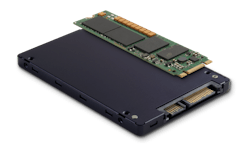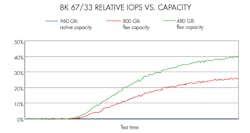TLC (triple level cell) flash storage is pushing its way into the enterprise with the promise of high capacity storage to replace magnetic disks. The challenge is delivering drive lifetimes that meet enterprise requirements while providing the superior performance of flash memory.
Micron Technology’s 5100 enterprise solid state drive (SSD) uses TLC flash to deliver from 240 Gbytes to 8 Tbytes of storage in platforms that include 2.5-in drives and M.2 modules (Fig. 1). The M.2 modules top out at 1,920 Gbytes. Sequential read speed is 549 Mbytes/s. The drives come in three flavors that address different applications:
- Micron 5100 ECO – It targets cloud services and it is optimized for content sharing, such as video and media streaming. It delivers consistent data throughput and fast information delivery, and can handle 1 driver write/day (DWPD).
- Micron 5100 PRO – This targets most applications by providing consistent performance for latency-sensitive applications. It supports 1 to 3 DWPD.
- Micron 5100 MAX – This family is designed for demanding storage applications. It supports up to 5 DWPD.
Part of the difference is the percentage of spare, over-capacity storage needed with flash memory. The ECO version has about 15%, while the MAX has 60%. Users can also take advantage of Micron’s FlexPro tuning support that allows this over-provisioning to be changed (Fig. 2). It can deliver up to 74,000 random write IOPS.
The three versions of the 5100 essentially have different default overprovisioning settings. These can be changed using the Storage Executive management software, although this is typically done when the drive is used. The tradeoff between long-term performance and capacity is one that users will need to consider, but they now have an option to make the adjustment (Fig. 3). The drives target the enterprise, but they are of interest for embedded applications, as well—especially when the drive performance and longevity can be tuned to the application.
Self-encrypting drive (SEC) support is optional, as is TCG Enterprise and FIPS 140-2 validation. The system uses Marvell’s 88SS1074 flash controller.
About the Author
William G. Wong
Senior Content Director - Electronic Design and Microwaves & RF
I am Editor of Electronic Design focusing on embedded, software, and systems. As Senior Content Director, I also manage Microwaves & RF and I work with a great team of editors to provide engineers, programmers, developers and technical managers with interesting and useful articles and videos on a regular basis. Check out our free newsletters to see the latest content.
You can send press releases for new products for possible coverage on the website. I am also interested in receiving contributed articles for publishing on our website. Use our template and send to me along with a signed release form.
Check out my blog, AltEmbedded on Electronic Design, as well as his latest articles on this site that are listed below.
You can visit my social media via these links:
- AltEmbedded on Electronic Design
- Bill Wong on Facebook
- @AltEmbedded on Twitter
- Bill Wong on LinkedIn
I earned a Bachelor of Electrical Engineering at the Georgia Institute of Technology and a Masters in Computer Science from Rutgers University. I still do a bit of programming using everything from C and C++ to Rust and Ada/SPARK. I do a bit of PHP programming for Drupal websites. I have posted a few Drupal modules.
I still get a hand on software and electronic hardware. Some of this can be found on our Kit Close-Up video series. You can also see me on many of our TechXchange Talk videos. I am interested in a range of projects from robotics to artificial intelligence.





